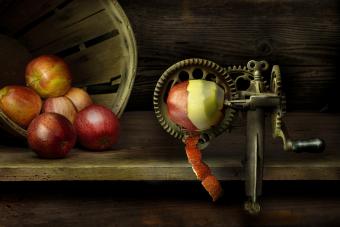
Decorative plate fans covet those who were alive during the 1970s and 1980s when plate collecting was at an all-time high, and one of the many options available were the Hummel plates manufactured by the German porcelain company, Goebel. Although the brand is better known for its cherubic figurines, their plates embody the delightful energy of their ceramic kids, and avid collectors will pay a pretty penny for a plate that will round out their annual collection.
The Goebel and Hummel Partnership
Sister Maria Innocentia (née Berta Hummel) was a Bavarian nun who, using her formal artistic training, partnered with Franz Goebels and his eponymous German porcelain company to bring her rosy-cheeked children to life. The first exhibition from their partnership was in 1935 and showcased their porcelain figurines of these quaint children. Quickly, the figurines became incredibly popular and were a typical family collectible by the 1960s. However, the two didn't limit their collaboration to only 3-D figurines and turned to a burgeoning medium in the 1970s - decorative plates.
Hummel Plates and Popular Styles
In an attempt to celebrate the factory's 100th anniversary, the company's design team devised a commemorative plate that would be released in 1971. Originally intended to be a single piece, the anniversary plate became so popular that the company would go on to create a few different series of plates between the 1970s to the early 2000s.
Annual Hummel Plates
The aforementioned Annual plate series encompasses the collection that includes a single plate to represent every year from 1971 to 1995. There was a five-year gap before the next annual plate was released, and only five more plates were added to the collection in this millennial production. The first Annual plate was created in 1971 in honor of the company's 100th anniversary and had three different reissues. The first of these was made for the company's employees and has an inscription on the bottom rim, which thanks them for their hard work. This plate is rather rare and correspondingly expensive. Following this plate was the American and English editions, the first of which had holes in the back rim to accompany a wall-mount. The subsequent plates that were released each year illustrated Hummel's idyllic visions in a unique, hand-painted scene.
Hummel Christmas Plates
The second most popular plate series from Hummel and Goebel's collaboration is their Christmas plates line. The earliest Christmas plates bear close resemblance to the Annual plates, but later editions differ from the Annual series in that they're designed with a relief style scene instead of a flat, painted image. These raised, three-dimensional plates were produced throughout the late 1990s. Overall, Hummel's Christmas plates are far less collectible than those from their Annual series are.

Miscellaneous Hummel Plates
Although these different Hummel plates aren't as well-known as the brand's Annual and Christmas series are, they are beloved by avid Hummel and Goebel collectors. Here are a few of the different series of plates that you or a loved one might have bought in a consignment store on your last vacation.
- Friends Forever Series
- Four Seasons Series
- Celebration Series
- Little Music Makers Mini-Plate Series
- Little Homemakers Mini-Plate Series
- Century Collection Mini-Plate Series
Authenticating a Hummel Plate
In much the same way that you can authenticate a Hummel figurine, you can verify a Hummel plate. You'll want to look for two separate identifiers on the back of the plate that should assuage any worries you might have about a plate's authenticity.
- Maker's Marks - Although Goebel's trademark system isn't exactly the same for its plates as it is for its figurines, the manufacturer has a consistent labeling process in place which ensures that you can easily identify the plate as belonging to the company based on the stamps/inscriptions on the back.
- HUM Numbers - In addition to looking for maker's marks, you should notice a number inscribed into the back of the plate; these HUM numbers correspond to the company's catalog, and the plate's design should match up exactly to the catalog's pattern.

Hummel Plate Values
Unfortunately, these plates monetary estimates aren't going to let you give up your full-time job to take a trip around the world. These plates had their highest values during the 1990s and early 2000s, when nostalgia for their mid-century annual releases was still high. Therefore, current plates that have been listed in auctions are expected to bring in anywhere between $20-$50 on average, though some ambitious sellers have posted their plates for thousands of dollars each. For example, the best case scenario (a vintage annual Hummel from 1984 with the box intact) is only listed for almost $50 in one online auction. Similarly, both a 1997 and a 1996 Christmas plate are estimated to be worth $25 each. Even a first edition 1971 Annual plate with the original box is listed for only almost $50. Thus, you probably want to hang onto any of these plates if you have them, particularly since there isn't a lot of demand right now for these Goebel and Hummel products.
Modern Meets Vintage With Hummel Plates
While it isn't the right time to sell your Hummel plates, that doesn't mean you can't use them to spruce up your space. You can marry vintage decoratives with modern design by using either elegant or rustic floating shelves to display the plates that are in your possession, and you just might inspire your friends and family to do the same with their beloved collectibles. Now, learn about more collector plate values.







